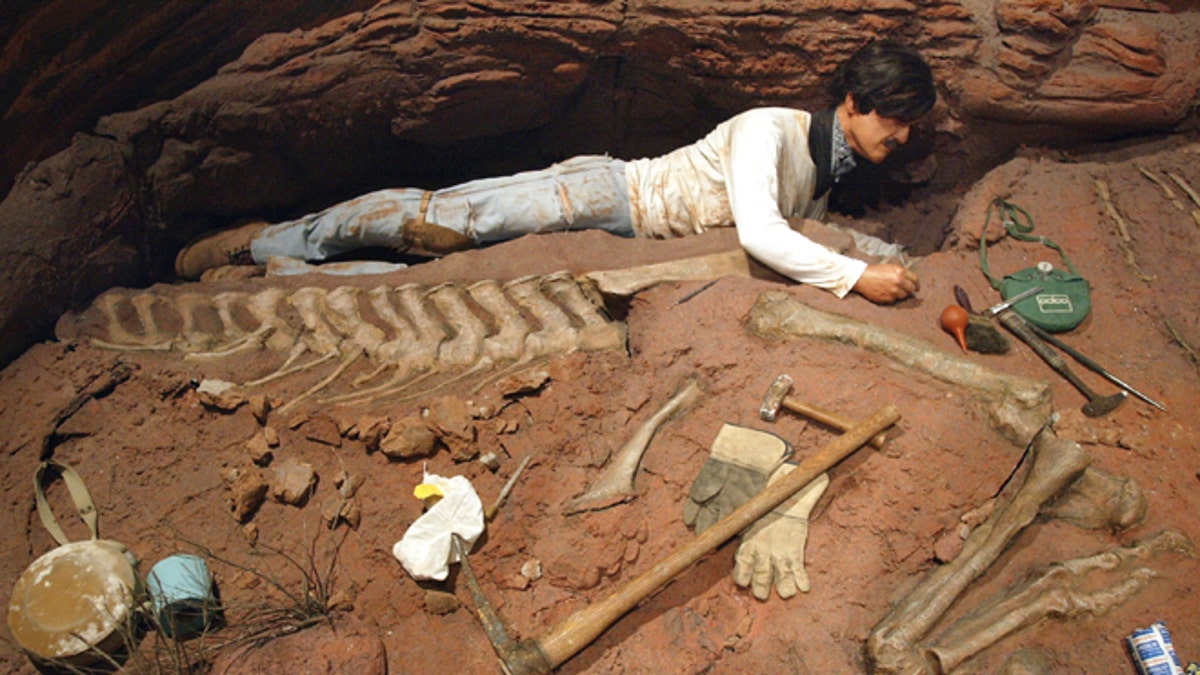
402200 03: A paleontologist digs for dinosaur bones in this life-size model of the "Tiniest Giants: Discovering Dinosaur Eggs" exhibit March 12, 2002 at Chicagos Field Museum. The exhibit comes from the 1997 discovery in southern Argentina of the largest nesting site of dinosaur eggs ever found. More than a mile square, the site held tens of thousands of eggs, some containing fossilized embryos so well preserved the scientists could see patterns of reptilian scales in their skin. "Tiniest Giants: Discovering Dinosaur Eggs" was developed by the Natural History Museum of Los Angeles County and the Carmen Funes Museum of Argentina. The exhibit is open at the Field Museum through September 2, 2002. (Photo by Tim Boyle/Getty Images) ((Photo by Tim Boyle/Getty Images))
Archaeologists from Germany and Mexico have unearthed what they believe is the largest dinosaur cemetery in the world in the Mexican state of Coahuila.
Researchers from the University of Heidelberg, the State Museum of Natural History in Karlsruhe and the Desert Museum in Saltillo, Mexico, have uncovered at least 14 fossils of what they believe to be dinosaurs in a tiny area only 164 feet by 656 feet in size. The researchers also found the bones of at least 15 more specimens only a few miles away.
“I know no other place where so many dinosaurs have been found on such a small area,” said Wolfgang Stinnesbeck from the University of Heidelberg, according to Russia's RIA Novosti.
While the area where the fossils were discovered looks like an inhospitable wasteland at the moment, 70 million years ago the desert landscape was actually a fertile piece of land.
“There was a huge delta here and several rivers were flowing into the Gulf of Mexico,” said paleontologist Eberhard Frey from the University of Heidelberg. “The ecosystem here was vibrant. Apart from dinosaur bones we have found four species of turtles, remains of a small crocodile and teeth of early mammals.”
Frey added that the researchers have found a footprint of a Theropod near the dig site. These dinosaurs were some of the largest predators in the Jurassic and Cretaceous periods.
“Our findings are very promising, large-scale excavation here would be worthwhile,” Frey said.
Latin America is a hotbed for dinosaur discoveries, although recently most of the major finds have occurred in South American nations like Argentina and Venezuela.
Last month archaeologists announced that the fossilized remains of a colossal creature were discovered in the Patagonia region of Argentina by a team led by Kenneth J. Lacovara, a paleontologist at Drexel University in Philadelphia. The Dreadnoughtus, which means "fear nothing," is the first of this species and most complete ever found of this group of dinosaurs known as titanosaurs.
“What we can say with certainty is this is the biggest land animal that we can actually put a number on,” Lacovara told the New York Times. “We’ve got 16 tons of bone in my lab right now.”
Scientists in Venezuela also recently announced the unearthing of a fox-sized dinosaur that walked on two legs, a relative of both the stegosaurus and triceratops that dates back around 200 million years.
The tiny new dinosaur, named Laquintasaura venezuelae or Greek for "lizard of La Quinta," also provides evidence that some creatures lived in herds and were able to survive in regions once thought too inhospitable for the dinosaurs.
Follow us on twitter.com/foxnewslatino
Like us at facebook.com/foxnewslatino

